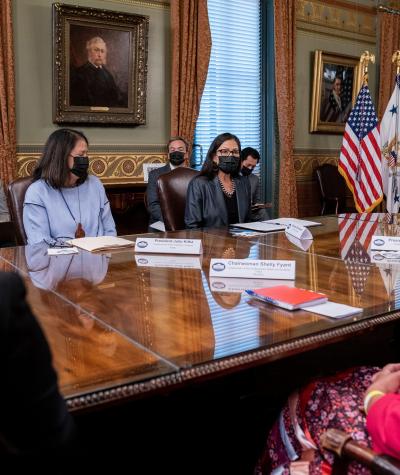Native American voters face several barriers to exercising their freedom to vote and making their voices heard in our government.
This is why on Dec. 6, 2021, Campaign Legal Center (CLC) sent letters to the U.S. Department of the Interior (DOI) and the U.S. Department of Housing and Urban Development (HUD), urging them to address those barriers through decisive action to increase voting access for Native American communities.
In March, President Biden signed an executive order expanding voting access. These letters ask DOI and HUD to take steps to follow through on pursuing solutions that help Native Americans vote.
Despite decades of advocacy and litigation by Native Nations and tribal citizens, Native Americans continue to face unique and substantial barriers to voting.
These include obstacles that make it more difficult to register to vote, challenges voting in person or by mail, receiving insufficient voter education materials, facing voter intimidation from non-Native poll workers, having tribal ID be recognized as a valid form of voter ID and noncompliance by states and localities with the language assistance provisions of the Voting Rights Act (VRA).
Additionally, Native Americans are often forced to vote under congressional, state and local district maps or at-large election systems that undermine their political representation through vote dilution, racial gerrymandering and malapportionment.
Consequently, there are more than one million Native Americans who are eligible to vote but are not registered. Voter turnout is lower amongst Native Americans than any other racial or ethnic group.
Following the executive order in March, DOI and HUD have begun to tackle these challenges. Schools operated by the DOI’s Bureau of Indian Education and Tribal Colleges and Universities are working to increase voter awareness and registration amongst Native youth and young adults by hosting in-person voter education events.
Meanwhile, HUD has announced its intention to engage with public housing authorities (PHA) to provide voter registration information and improve voting access for people experiencing homelessness – two strategies CLC recommended in a previous letter to the agency.
Yet there is still more each agency could do to promote voting access for Native Americans.
How DOI Can Improve Native Americans’ Voting Access
To help Native Americans vote, CLC’s letter recommends that DOI establish a voter registration and education program in coordination with tribal governments and offer voter registration opportunities for people accessing programs offered by the Bureau of Indian Affairs.
Coordinating with other federal agencies to gather better data on voter registration and turnout rates could also increase participation.
DOI should also distribute information regarding mail voting at voter education events, work with the United States Postal Service to identify and resolve barriers to mail delivery and pickup on tribal lands and facilitate coordination between tribal governments and state and local officials to establish ballot pickup and drop-off locations on tribal lands.
Finally, it should conduct voter outreach on and create and distribute a toolkit to state and local governments for language assistance, as well as collaborating with tribal governments and other federal agencies to ensure that future American Community Surveys and Decennial Censuses accurately count and capture the characteristics of tribal communities.
How HUD Can Assist Native Americans with Voting
There are several ways that HUD can use its existing authority and relationships to meaningfully expand access to voting for Native people. Specifically, through the Office of Native American Programs (ONAP), HUD can provide resources to voters in Native communities.
A few ways ONAP can do this is by offering information and voter registration opportunities through its housing and home lending programs, informing voters whether particular Tribal ID cards qualify as voter ID under state law and providing voting information in the Indigenous languages of the communities it serves, including those that are not required under the VRA.
HUD can also help Native voters with accessing and submitting vote-by-mail applications where necessary and assist with identifying polling place locations and publicizing polling place changes, a common problem voters face given the high rates of housing insecurity and frequency of address changes in many Native communities.
We must continue to push DOI and HUD to deliver on the White House’s promising of expanding voting access for Native Americans. We should get rid of deliberate or unnecessary barriers to voting for Native communities because we all deserve to be able to exercise our freedom to vote and have an equal say in our future.

